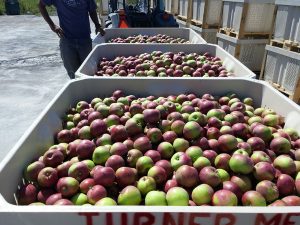Harvest Date Affects Storability
 Many changes occur in the fruit as ripeness progresses from the mature green stage to over ripeness. Fruit color develops from green to yellow and in many varieties, the skin develops red or purple color. Fruit size increases, and flesh firmness decreases. Flavor changes from tart to bland, and sweetness increases as fruit ripen. Since these traits define fruit quality, the stage of ripeness impacts consumer acceptance. The change in these qualities can be used to determine if fruit are at a good stage for picking. Plums and peaches also hold up better during cold storage and marketing if picked at earlier stages of ripening and will continue to ripen. When fruit are marketed locally and within days of harvest, they may be allowed to ripen on the tree to improve flavor. Sweet cherries do not continue to ripen once they are harvested, and should be picked at peak quality.
Many changes occur in the fruit as ripeness progresses from the mature green stage to over ripeness. Fruit color develops from green to yellow and in many varieties, the skin develops red or purple color. Fruit size increases, and flesh firmness decreases. Flavor changes from tart to bland, and sweetness increases as fruit ripen. Since these traits define fruit quality, the stage of ripeness impacts consumer acceptance. The change in these qualities can be used to determine if fruit are at a good stage for picking. Plums and peaches also hold up better during cold storage and marketing if picked at earlier stages of ripening and will continue to ripen. When fruit are marketed locally and within days of harvest, they may be allowed to ripen on the tree to improve flavor. Sweet cherries do not continue to ripen once they are harvested, and should be picked at peak quality.
Cold storage and other postharvest techniques slow down the progression of ripening and can counteract the natural loss of quality. For many apple varieties, the expected storage duration depends on ripeness at harvest. Apples picked at the mature green stage can be cold stored up to 4 months if conditions in the orchard and in storage are ideal. However, most summer-ripening varieties can only be stored a few weeks without losing quality. Fruit picked after some ripening has occurred can be kept in cold storage for 2-3 months depending on the variety. Once they are fully ripe, storage life of apples is limited to one month or less depending on temperature in cold storage. Over-ripe fruit will not keep in good condition with or without cold storage. Stone fruit can be held in cold storage, but for a much shorter duration of two to three weeks.
